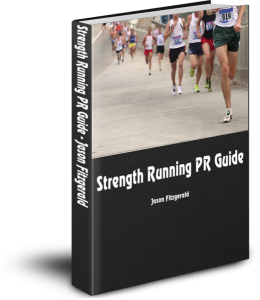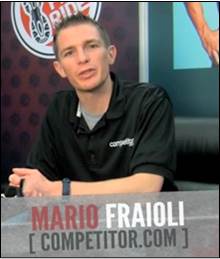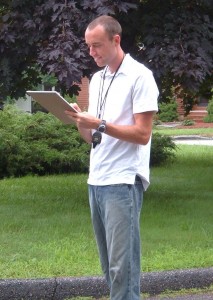Can you imagine trying to pace yourself evenly when you’re running on a course like this?
Getting your splits to be even – or within the range you should be at – can be nearly impossible when you’re dealing with so many obstacles:
- Technical trails
- Heat and humidity
- Freezing cold
- Hills and elevation changes
- Altitude
- Taking time off from running
But a lot of runners are adament about staying in the right pacing zone – even when every variable is working against them.
Just the other week I reassured one of my runners that it was ok if her tempo pace was 5 seconds per mile too slow (it was 90+ degrees!).
The human body isn’t a machine. We must adjust our pace expectations when conditions aren’t ideal.
But when they are ideal, it’s time to execute flawlessly during a workout and push ourselves to the limit during a race.
Today we’re going to cover:
- The top pacing questions I’ve received in the last 4+ years
- Race strategy from elite coaches and accomplished runners
Pacing and race strategy are some of my favorite aspects of running because it’s so easy to get wrong, but also so easy to get right.
Pacing Q&A
I’ve answered thousands of running questions over the years – and today, I want to highlight three of the most common pacing questions that stump most runners.
This section is an excerpt from the Strength Running PR Guide – a free digital book that answers 35+ running questions.
Question #1:
Online calculators online and books (Daniels, Galloway, McMillan, Runner’s World, etc.) have the easy pace and the long run pace set at a pace that feels sooooo slow for me.
Will it hurt my training or pose a risk of injury to run faster if it still feels easy?
Answer:
The short answer: no way! If a certain pace feels easy, then it’s easy. But here’s the caveat: that pace has to feel easy for the entire run to truly be considered easy. If I were to start running every run at 5 minute mile pace, that would feel easy…for the first minute.
Make sure you can hold a conversation during your easy runs. If you can do that, you’re not risking an injury. Your long runs should typically be a moderate effort and could venture into “hard effort” territory during the last few miles if you’re fatigued.
I recommend that runners run “by feel” on their runs so instead of being married to a particular pace, run what your body is ready for on that particular day.
Additional reading: How fast should I run on my easy runs?
Question #2:
I’m coming back from a long layoff of no running. I used to run my normal distance runs a lot faster but now I’m slower. How can I get back to my old pace per mile?
Answer:
For right now, I wouldn’t worry about your pace.
When you’re getting back into the swing of training, the effort level of your runs should be low-moderate, no matter the pace. This is the strategy I took after my layoff from ITBS and it worked well. Your body just isn’t ready to physically handle those harder runs.
By staying consistent, strategically running moderate paced workouts when you’re ready, and running simple strides after your distance runs your body will gradually get in better shape. It can be a long road ( it took me a year!), but the patience pays off in dividends.
Additional reading: What are strides? and The Untold Story of My IT Band Syndrome Treatment
Question #3:
How do I get over the middle part of a race where I always slow down?
Ah, the essence of successful racing! I wish there was an easy answer for this question.
If you’re slowing down in the middle of a race but not at the end, then that probably means it’s not an endurance problem. Being able to run strong at the end of a race means you have a solid aerobic foundation that enables you to hold a fast pace when you’re fatigued.
Slowing down in the middle of the race could be because of several reasons:
- You went out too fast. Races aren’t won in the first two minutes, but they can be lost. It’s fine to run faster in the first several minutes or mile of a race than your goal pace, but don’t go overboard or you’ll pay the consequences later.
- You could lack confidence and the mental toughness to hold on to your pace. Improving confidence can be done by running race-specific workouts, exposing yourself to race pain more frequently, and successful training.
- Not enough race pace running in your training. Your body will be shocked when it tries to run race pace if you never do it in training. Specificity is key.
Additional reading: Race Strategy 101 (Q&A with Coach)
Want more? The full book has more than 35 questions and answers that you can browse.
Pacing Yourself During Races
Race strategy can take many forms. Are you trying to win your age group? Just finish? Or maybe you’re gunning for a pesonal best and want to finish strong.
Whatever your goal, a good race strategy is a must-have to perform at the level that will help you achieve your goals.
And I have 13 different race strategies for you – all from pro coaches, Boston Qualifiers, ultra runners, and college All-Americans. So you know the advice is rock-solid.
You can download the free book here with every race strategy included.
Today I’m highlighting two of my favorite strategies, one from Mario Fraioli and the other from Jeff Gaudette.
Mario’s “Tighten the Screws” Strategy
Tightening the screws is a racing tactic I like to employ for distances from 5K to half marathon. It’s a strategy that can be used in the marathon as well, but for most runners it’s not worth the risk.
How do you do it? It’s as simple as throwing in a series of surges during a race when your competition least expects it. The goal is to take an opponent out of their rhythm in an effort to get away from them before the finish line.
As a general rule, the shorter (i.e. more intense) the race, the shorter the surges. For example, when racing a 5K, throw in a hard 15 to 30-second surge (10-20 seconds per mile faster than you averaged for the first mile), then return to your race rhythm.
Didn’t shake your opponent? Do it again at mile 2. Is he still there? Throw in one final short surge with half a mile to go to try and take the finishing kick out of their legs.
In a 10K or half marathon race, since the overall effort level is less intense than it is for a 5K, stretch the surge out a bit to a minute or more. After three to four well-timed surges you’ll wear your opponent down and leave them wondering where you went!
Don’t wear a watch while racing? Pick points along the course and surge to the next light post, or stop sign, or some other landmark. Explode when you’re coming off a turn, or kick it into high gear after cresting a hill. The idea is to keep your competition guessing all the way to the finish line.
Of course, don’t try this tactic without practicing it first! Rehearse surging and recovering during tempo runs and long runs so that it doesn’t backfire when you try it in a race.
Next time you’re having trouble shaking your competition, try tightening the screws on them!
Mario Fraioli is a senior editor at Competitor Magazine. He was a cross country All-American at Stonehill College and has personal bests of 4:09.77 in the mile, 14:39 for 5,000m and 2:28:25 in the marathon. He coaches the Prado Women’s Racing Team in San Diego and was the men’s marathon coach for Costa Rica at the 2012 Olympic Games.
Jeff’s “Surge to Get Back on Pace” Strategy
A common racing mistake I’m guilty of myself, and I see athletes I coach make, is slowly letting the pace slip during the middle of a race, often without realizing it. As your legs tire and your breathing becomes labored, maintaining goal pace gets more difficult.
More specifically, the effort required to run goal pace during mile 8 of a half marathon is exponentially harder than the first mile.
The solution is to analyze your splits from previous races at the same distance and identify where this natural slow down occurred. If you have the data from your previous three to four races, you can usually find a common point in any race distance where you start to fade.
If you’re new to the race distance, a good tip to remember is that the average slowing point will occur just after half way – usually between half way and three quarters of the race. For example, the slow point in a 5k usually happens at 3000 meters.
Once you’ve found your slow spot, surge at this exact moment in your next race. It doesn’t have to be that much faster than your goal pace, but consciously thinking about your pace when you normally have trouble will be a mental reminder to not let your it slip. This doesn’t necessarily make it easier to keep pushing yourself, but it helps prevent unintentional pace creep that’s so common.
How to implement in training
Like any racing tactic, you don’t want to rely on a new strategy without practicing it in training first. So, include a few 60-90 second surges during your next long run or try inserting a hammer during your next track session (a hammer is running the second to last repeat of your interval session as fast as you can and then returning to normal interval pace for your last repeat).
Both of these workouts teach your mind and body to increase its effort during a workout similar to your goal race. You’re training your body to dramatically increase the effort level as the workout goes on and will be more prepared to do so during the race.
Jeff Gaudette is a USATF and RRCA-certified running coach, two-time Division-1 All-American in Cross Country while at Brown University, and a former professional runner for the Hansons-Brooks team. He is an Olympic Trials qualifier in the 10k (28:46 PR) and marathon (2:22:02 PR) and is the founder of Runners Connect.
The full book contains race strategy advice from:
- Jay Johnson, Running Times contributor and creator of the Building a Better Runner DVDs
- Thad McLaurin, certified coach and personal trainer
- Mario Fraioli, 2:28 marathoner and senior editor at Competitor Magazine
- Joel Runyon, ultramarathoner and triathlete
- Jeff Gaudette, Olympic Trials Qualifier and former Hansons-Brooks professional runner
- Nicole Antoinette, marathoner and hater of all bullshit
- Doug Hay, ultramarathoner and trail runner
- Susan Lacke, Ironman Triathlete and contributor to Competitor and Triathlete magazines
- Laura Schwecherl, marathoner and former Outreach Director for Greatist
- David Hylton, co-creator of #RunChat
- Matt Frazier, founder of No Meat Athlete and Boston Marathon Qualifier
- Mark Kennedy, former kinesiologist
- Me!
You can sign up here if you’d like the entire book.